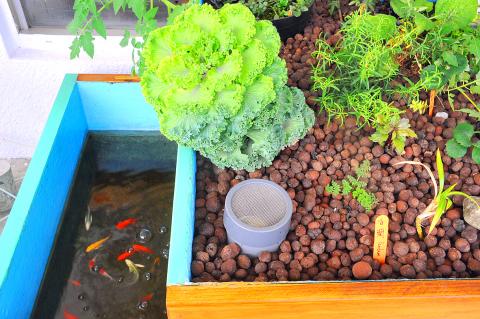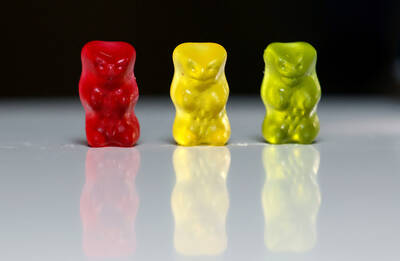Imagine having a portable garden on your balcony, roof or yard that you do not have to water regularly and comes with a fish pond that does not require you to change the water. If you are not squeamish, you can even kill and eat the fish for dinner.
That is, essentially, what aquaponics is — a dream come true for busy urbanites who harbor secret gardening aspirations but just cannot find the space or time.
Frank Wei (魏得軒) of Aquaponics Innomaker (魚菜創造家) has several displays on the balcony of Red Room in Taipei. The more complex one has lettuce, coriander, mint and eggplant growing on a bed of clay balls, called “hydrotons,” on a movable top layer. The bottom layer is the fish pond — with pods of quinoa floating on top of the water.

Photo: Han Cheung, Taipei Time
The system is quite simple: water and fish waste (ammonia) are pumped up to the top layer, where the bacteria in the clay balls break down the ammonia into nitrates, which are absorbed by the plants. The leftover water is aerated clean and siphoned back into the fish pond.
Of course, some work has to be done, such as feeding the fish and monitoring water quality.
“I have not changed the water in five or six months. It is still clean and does not smell,” Wei says. “The vegetables absorb water, so occasionally I have added a few buckets. It is easy and convenient.”
Wei and his colleagues will be sharing their expertise and explaining the workings of the system at the Red Room tomorrow. Attendees can also try aquaponic produce and tea made from aquaponic herbs.
Wei says the plants not only help clean the air, but also create a microclimate that lowers the temperature of the house where it’s located, saving electricity costs in the summer. The cost to run the system is minimal — he says about NT$20 to $30 per month in electricity — and it also conserves water.
But the main point is becoming an urban farmer and growing fresh food in your own house in a city where arable land is becoming increasingly expensive.
“We talk about reducing our food miles — the distance food is transported — but it is difficult to accomplish in Taipei, especially if you want to eat quality ingredients. So you strive to at least produce part of the food on your own.”
Wei uses edible fish such as tilapia in his own systems, but he says many urbanites start to see the fish as pets and are unable to kill them, so he recommends decorative species like goldfish that are easier to keep alive.
Wei envisions a community where everyone grows and exchanges produce. Roofs are ideal if one can get all the residents on board for a much larger-scale system, but right now the company is designing smaller, easier-to-manage systems.
When Wei gets enough interest, he wants to promote community-supported agriculture with aquaponics.
“Farmers would not have to worry about taking their produce to the market — the residents will support them,” he says. “With a stable customer base, he would not need to add all kinds of pesticides. It will be a good way to alleviate food safety issues and combat increasing produce prices.”
Other applications Wei envisions include horticultural therapy for elderly citizens, who will not face mobility problems with such an simple system.
“The point of horticultural therapy is not the manual labor, it is the joy of watching [plants] grow,” he says.

The canonical shot of an East Asian city is a night skyline studded with towering apartment and office buildings, bright with neon and plastic signage, a landscape of energy and modernity. Another classic image is the same city seen from above, in which identical apartment towers march across the city, spilling out over nearby geography, like stylized soldiers colonizing new territory in a board game. Densely populated dynamic conurbations of money, technological innovation and convenience, it is hard to see the cities of East Asia as what they truly are: necropolises. Why is this? The East Asian development model, with

June 16 to June 22 The following flyer appeared on the streets of Hsinchu on June 12, 1895: “Taipei has already fallen to the Japanese barbarians, who have brought great misery to our land and people. We heard that the Japanese occupiers will tax our gardens, our houses, our bodies, and even our chickens, dogs, cows and pigs. They wear their hair wild, carve their teeth, tattoo their foreheads, wear strange clothes and speak a strange language. How can we be ruled by such people?” Posted by civilian militia leader Wu Tang-hsing (吳湯興), it was a call to arms to retake

Desperate dads meet in car parks to exchange packets; exhausted parents slip it into their kids’ drinks; families wait months for prescriptions buy it “off label.” But is it worth the risk? “The first time I gave him a gummy, I thought, ‘Oh my God, have I killed him?’ He just passed out in front of the TV. That never happens.” Jen remembers giving her son, David, six, melatonin to help him sleep. She got them from a friend, a pediatrician who gave them to her own child. “It was sort of hilarious. She had half a tub of gummies,

The wide-screen spectacle of Formula One gets a gleaming, rip-roaring workout in Joseph Kosinski’s F1, a fine-tuned machine of a movie that, in its most riveting racing scenes, approaches a kind of high-speed splendor. Kosinski, who last endeavored to put moviegoers in the seat of a fighter jet in Top Gun: Maverick, has moved to the open cockpits of Formula One with much the same affection, if not outright need, for speed. A lot of the same team is back. Jerry Bruckheimer produces. Ehren Kruger, a co-writer on Maverick, takes sole credit here. Hans Zimmer, a co-composer previously, supplies the thumping